MiGs, Stars & Magic Books: A Brief History of Trespassing in Moscow
An illustrated guide to urban exploration in the Russian capital.

13 February 2014
Built for over a million people, the city of Ordos was designed to be the crowning glory of Inner Mongolia. Doomed to incompletion however, this futuristic metropolis now rises empty out of the deserts of northern China. Only 2% of its buildings were ever filled; the rest has largely been left to decay, abandoned mid-construction, earning Ordos the title of China’s Ghost City.
Last year I travelled to Inner Mongolia for myself, to get a closer look at the bizarre, ghost metropolis of Ordos… and the experience, as I would discover, was far stranger than anything I could have prepared for.

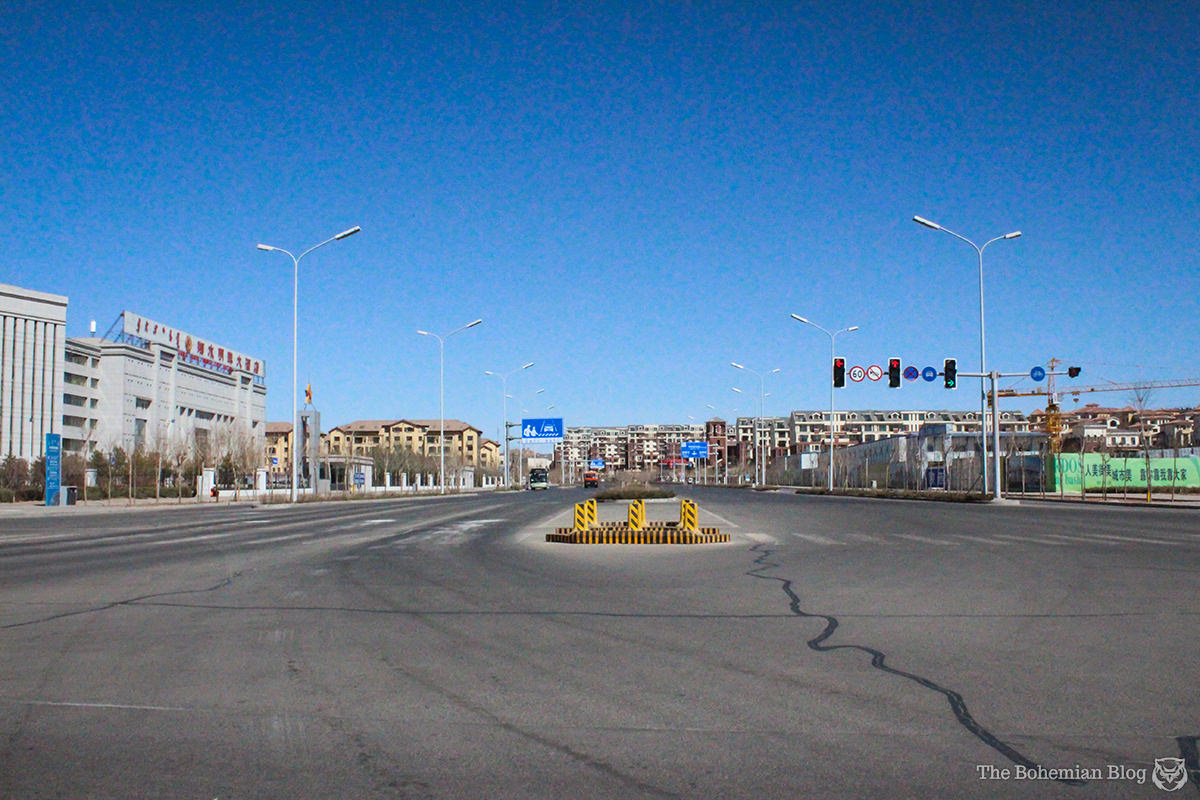
China’s property market is in a strange place.
 With a population reckoned at 1,351,000,000 and rising fast, the resultant boom in property development has led to scores of new-made millionaires and a rapidly growing elite class; at the same time however, analysts fear that this property bubble is set to burst. The country itself owes coming on for a trillion dollars in debt.
With a population reckoned at 1,351,000,000 and rising fast, the resultant boom in property development has led to scores of new-made millionaires and a rapidly growing elite class; at the same time however, analysts fear that this property bubble is set to burst. The country itself owes coming on for a trillion dollars in debt.
Meanwhile, a billion people are waking up to the possibilities of fast cars, smartphones, broadband Internet and credit cards.
Some of China’s most rapidly developing cities are virtually unheard of in the West; but for every overnight economic success story, there seems to be a hidden swathe of near misses, dead ends and bankruptcies. Out of all these phantoms however, nothing compares to the strangeness of China’s ‘Ghost City’: Ordos.
The city of Ordos is a heavily stylised population centre located close to the Ordos Desert, and it’s one of the main cities of Inner Mongolia. This area is famed for its rapidly expanding population and developing urban areas – the region of Inner Mongolia boasting a higher GDP than even Beijing itself.
Inner Mongolia is an interesting place. Once the birthplace of Genghis Khan, only 79% of the population belong to China’s predominant Han ethnicity, while 17% are of Mongol origin. It was once a part of Greater Mongolia, though consecutive Chinese empires and the latter-day rise of the Communist Party saw Inner Mongolia moulded and cast, time and time again, as a subservient province of China.
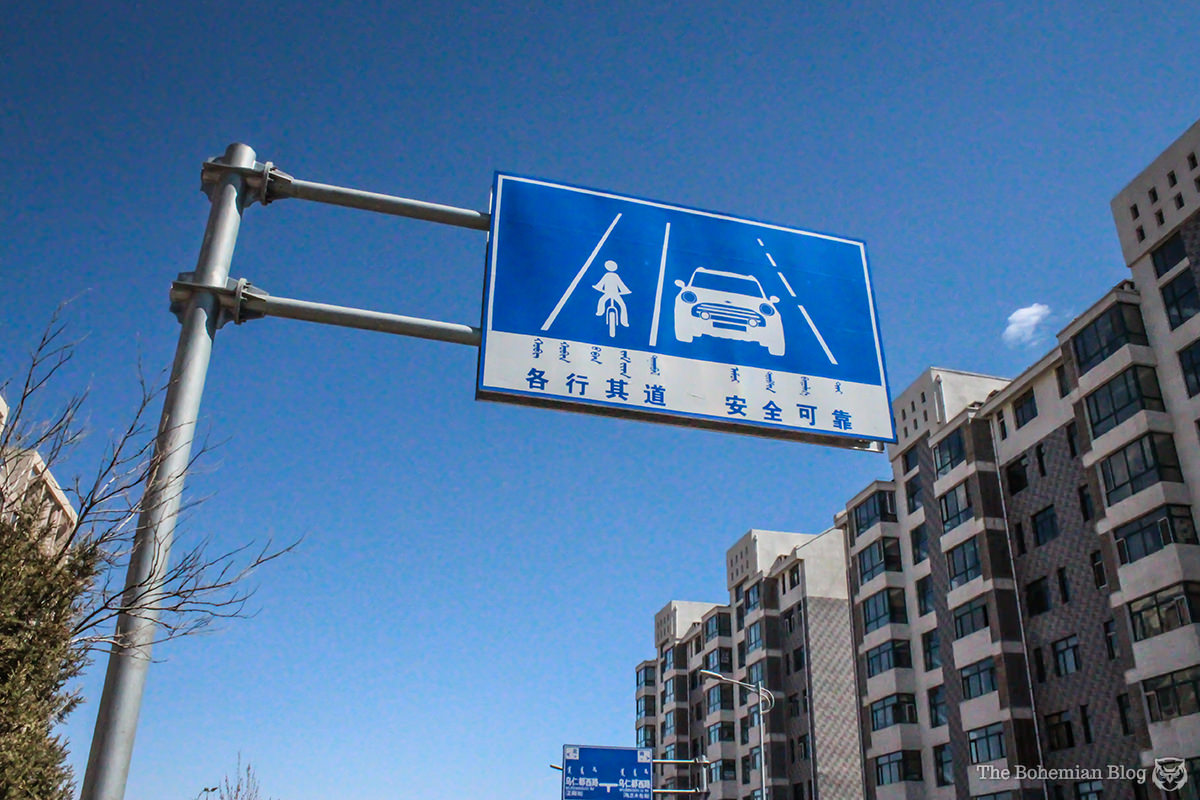

Interestingly however, Inner Mongolia is one of the only places in the world that still uses traditional Mongolian script. While Mongolia itself adopted Cyrillic during the communist years, perhaps the Mongols of China felt they had more to prove; clinging fiercely on to their heritage, and with it, the ancient characters that still now appear on street signs across Ordos and Kangbashi.
When a conglomeration of property developers began planning a new urban centre just outside the existing city of Ordos in 2003, the Kangbashi New Area, Ordos seemed set to become the futuristic jewel in China’s crown of city states.
 However, nobody quite anticipated how quickly this new development would fall flat on its face. Deadlines weren’t met, loans went unpaid, and investors pulled out before projects could be completed – leaving entire streets of unfinished buildings. The ridiculous cost of accommodation in this dream city put off many would-be inhabitants, so that even fully completed apartments became difficult to sell.
However, nobody quite anticipated how quickly this new development would fall flat on its face. Deadlines weren’t met, loans went unpaid, and investors pulled out before projects could be completed – leaving entire streets of unfinished buildings. The ridiculous cost of accommodation in this dream city put off many would-be inhabitants, so that even fully completed apartments became difficult to sell.
According to one local taxi driver I spoke to, many of those who did make the move to Kangbashi were already abandoning their homes – and breaking out of the ghost town.
While some developers still labour on with their thankless construction projects, others are busy slashing prices. Typical housing prices in Kangbashi have fallen from $1,100 to $470 per square foot, over the last five years alone.
Nowadays the Kangbashi district, planned to accommodate a population in excess of one million, is home to a lonely 20,000 people – leaving 98% of this 355-square kilometre site either under construction or abandoned altogether.

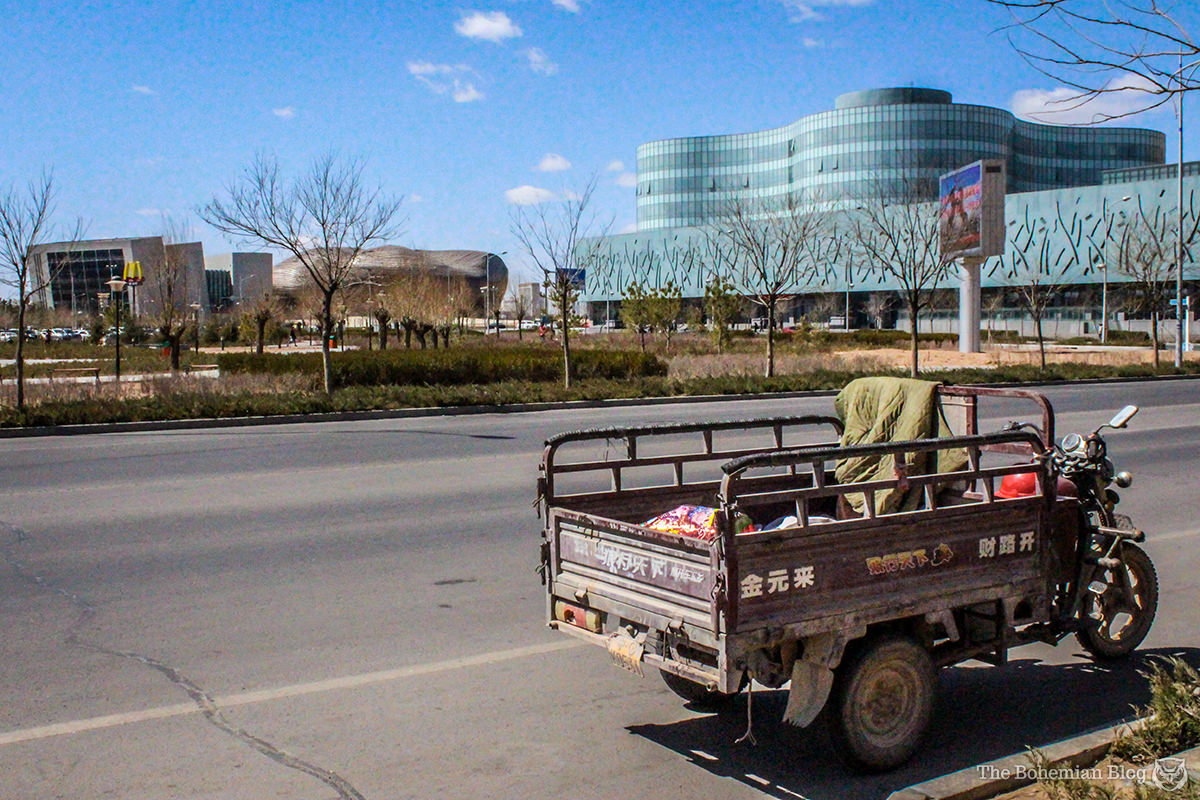 A November 2009 report on AlJazeera exposed the city of Ordos to a worldwide audience, and the story was run the next year by Time Magazine. Pretty soon, Ordos had earned the accolade of ‘China’s Ghost City’.
A November 2009 report on AlJazeera exposed the city of Ordos to a worldwide audience, and the story was run the next year by Time Magazine. Pretty soon, Ordos had earned the accolade of ‘China’s Ghost City’.
Journalists and photographers representing a number of world-renowned publications have since been to capture Kangbashi’s empty streets, its row upon row of apartment blocks abandoned mid-construction.
But for all that, none of these reports seemed to venture far from the city centre and its adjoining streets; resulting in broad, post-apocalyptic cityscapes that left much to the imagination. The more I read about Ordos, the more I wanted to know what lay beyond these hastily fitted doors and windows; to actually see inside, and under the skin of a city that never came to be.
Last year, my dream became a reality. I teamed up with Gareth from Young Pioneer Tours – a man just about crazy enough to share my fascination for this otherworldly ghost metropolis – and together we started planning our journey into Inner Mongolia.
The city of Ordos is served by the newly-built Eerduosi Airport. From the moment we got off our plane, it was apparent that someone, sometime, had made grand plans for this city.
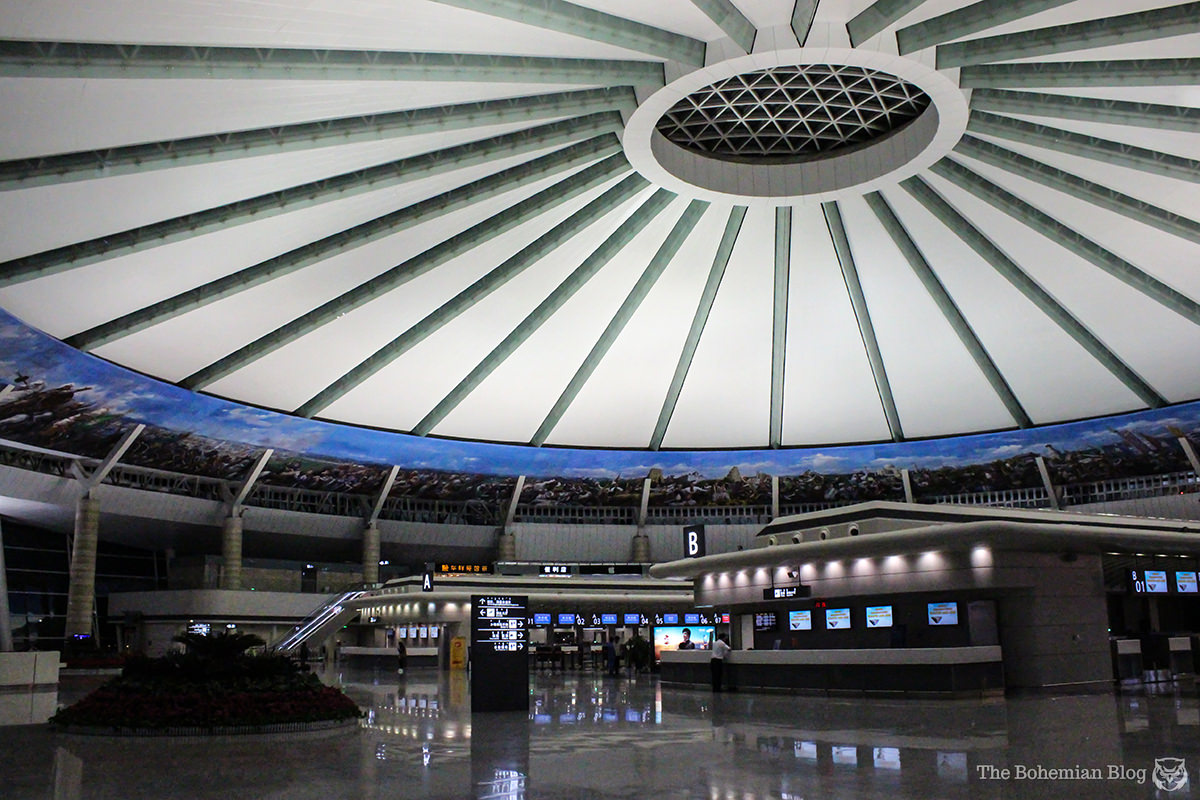

The futuristically sculpted terminal building is decked out with fountains and hanging baskets, chic coffee shops and sub-lit escalators glowing in shades of green and blue.
While the population of Ordos is now just 10% Mongolian to 90% Chinese, nevertheless the airport was resplendent with proud icons of a Mongolian heritage; effigies of horses and minstrels gaze down across the central concourse, while the departure hall features a vast mural, a ring of painted scenes depicting the life of Genghis Khan.
For all this opulence though, the airport was close to empty.

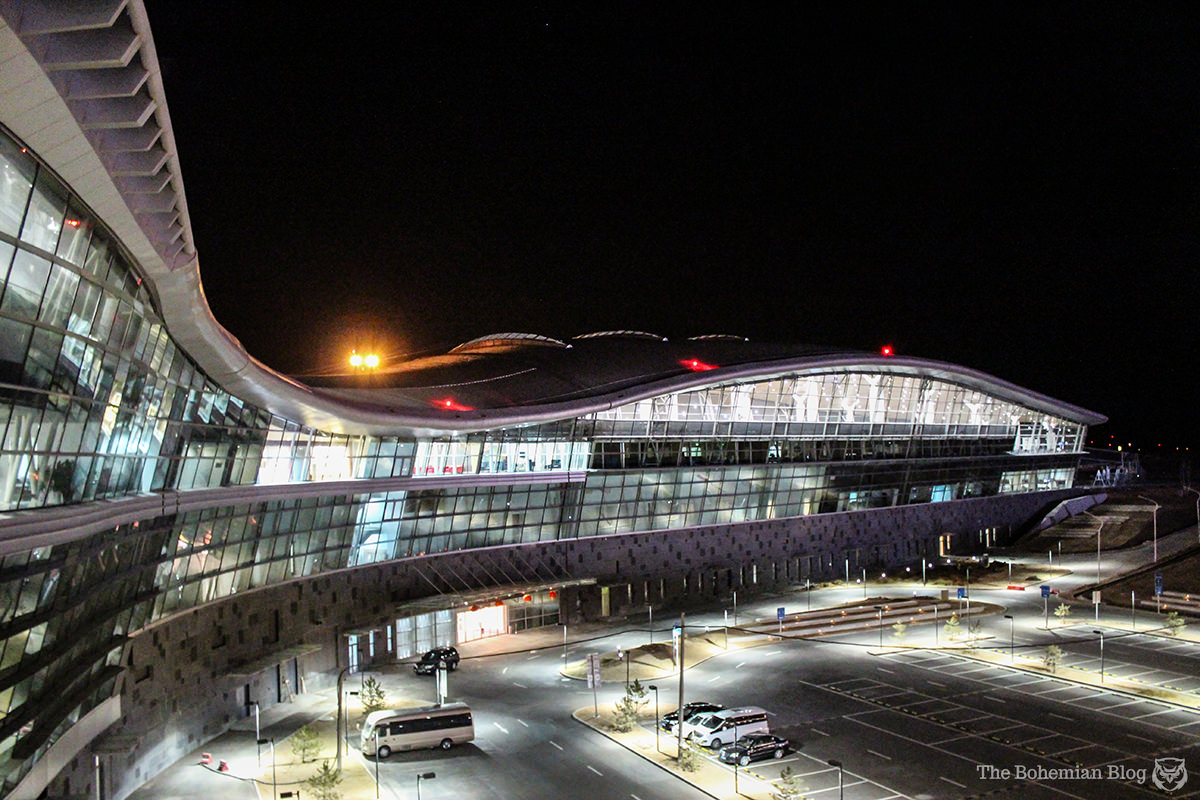
We took the second of two daily flights from Beijing to Eerduosi; departing from the smaller, former military airfield in the suburbs of the capital. It brought us to Inner Mongolia after dark, and we hopped onto the transfer coach headed towards Ordos city centre.
We were on this luxurious coach for around half an hour, enthroned in soft reclining seats replete with cup holders, leg rests and a movie channel… all the while, half-seen hulks of concrete and metal sped past our windows, distant, shadowy shapes appearing and disappearing out of the gloom.
I felt hemmed in on all sides by invisible construction sites. It was hard to make out much of our surroundings, given the bright interior lighting on the coach. On the final stretch into Ordos however, we passed by the shell of a stadium-to-be; the vast, skeletal seating areas rose up in a ring around a central playing field, lit by industrial spotlights and the regular, telltale flares of several hundred welding guns.
Never in my life have I seen anything so closely resembling the second Death Star.
 We arrived in Ordos sometime in the early hours of the morning, checked our bags into a hotel, and grabbed a beer for the road. The city centre is not a long way off completion: it has shops and apartments, cafés, bars and restaurants. For all this seeming normality however, downtown Ordos is presided over by a series of doom-struck towers, grey office buildings, flats and shopping malls – and most of them are completely empty.
We arrived in Ordos sometime in the early hours of the morning, checked our bags into a hotel, and grabbed a beer for the road. The city centre is not a long way off completion: it has shops and apartments, cafés, bars and restaurants. For all this seeming normality however, downtown Ordos is presided over by a series of doom-struck towers, grey office buildings, flats and shopping malls – and most of them are completely empty.
We walked for a few hours, past restaurants, bars, casinos and sex shops. The lights were shining bright in every establishment, but the people were nowhere to be seen. Cutting through one backstreet, we passed the pink lights of a brothel. The shop front was lined in wide, glass windows, to expose a troupe of young girls stood as if on parade in a wardrobe of matching lingerie. These dozen-or-so prostitutes numbered more than any pedestrians we’d managed to count all evening.

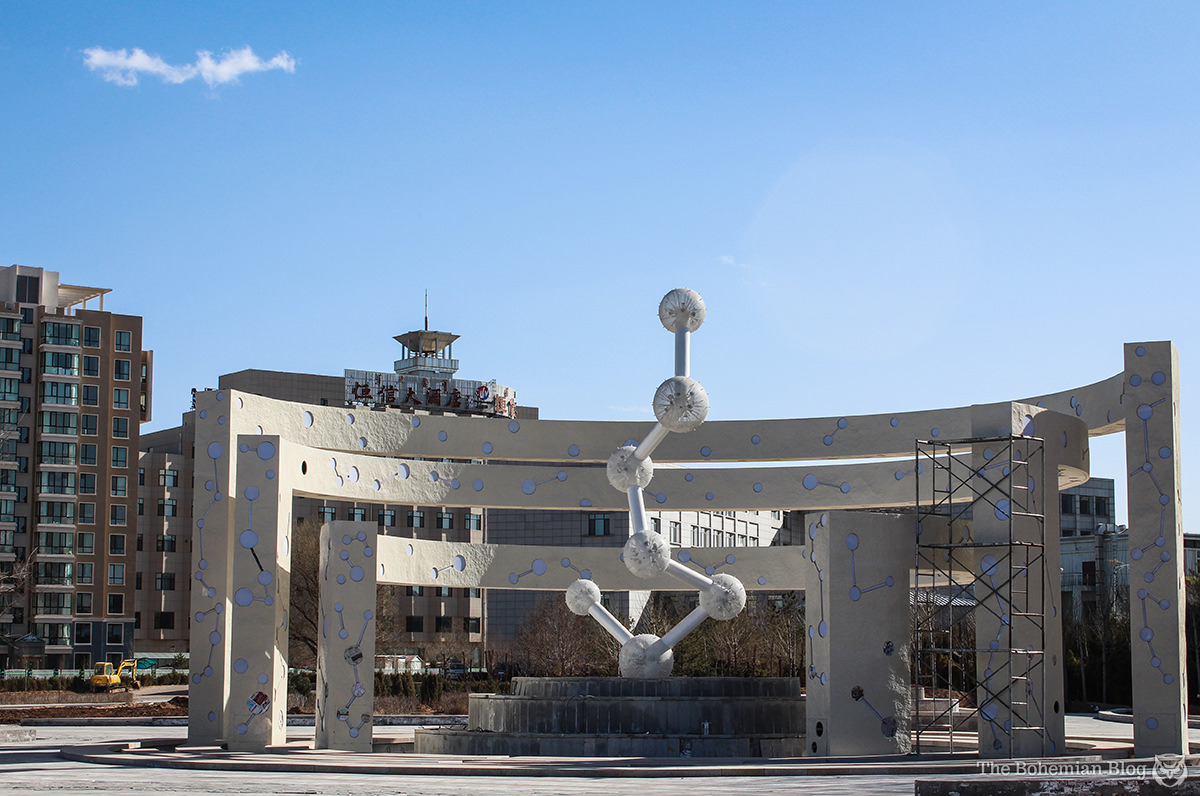
Everywhere, there seemed to be a show of readiness; of establishments with their doors thrown wide open, not just to welcome guests but also, perhaps, to prove a point. To show this city for the functional, hospitable destination that it so desperately wants to be.
We tried to get something to eat at a backstreet restaurant, approaching the doorway where local kids were fighting with a water hose.
“Do you have food?” we asked.
“Come in, come in,” they said, gesturing at a dimly lit booth within, at the fridge beside it stocked with cold noodles and soft drinks. There was no sign of an adult on the premises, no sight nor smell of a chef at work. As with so much else in Ordos, the lights were on but nobody was home.

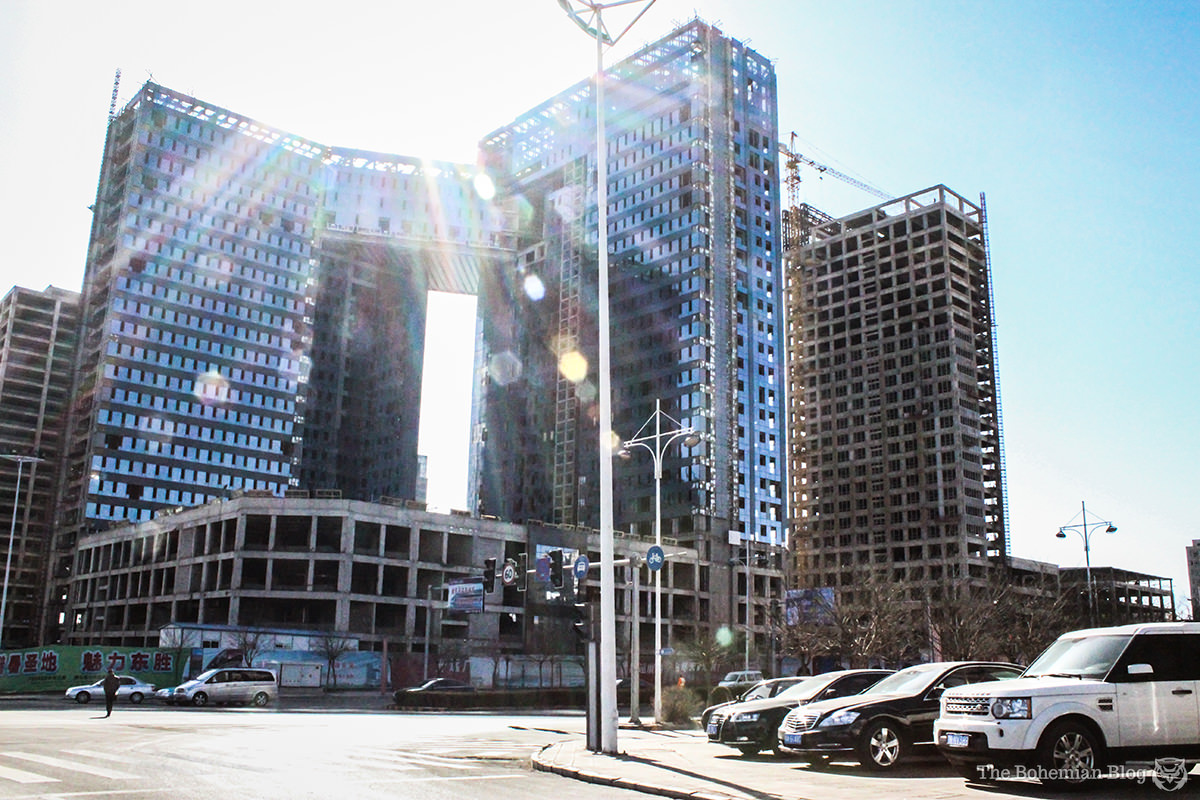 By the time we got back to our hotel, to its luxuriously oversized beds and in-room bars that featured whisky, peanuts and gas masks, we were still struggling to get to grips with this place, to make sense of the city.
By the time we got back to our hotel, to its luxuriously oversized beds and in-room bars that featured whisky, peanuts and gas masks, we were still struggling to get to grips with this place, to make sense of the city.
Through and through it felt like a construction site: a builders’ canteen stretched to accommodate a full city. For working men, there were primal comforts aplenty – bars, snacks and brothels – but while the fine restaurants and casinos made a show of being ready for tourists, delegates, or better still, investors, most of them were no more than empty fronts and meaningless displays.
By the light of the following morning, we got our first impression of the sheer scale of abandonment. We stopped off for a fast-food breakfast, the restaurant cowering in the shadow of the city’s CBD. In place of industrious office buildings however, a series of hollow fingers rose up to the sky; the shells of would-be towers, one after another, row after row, vanishing off into the distance.
Immediately above us towered what could have been the headquarters of a bank – forty floors of office space, wrapped in a shell of mirrored panels. In its un-maintained state however, these reflective scales were falling away in great swathes, to expose the bare concrete beneath. Not even finished yet, and already it needed a makeover.

We found a mosque near the city centre, a modern, cubist structure formed out of clean, white blocks. On closer inspection, it appeared as though the temple had never yet been used; peering through the glass doors we saw nothing inside but open space, while the doors themselves were still wrapped in plastic – as though fresh out of a warehouse somewhere, and hastily assembled.
 Before proceeding to our main destination, we decided to get a better look around this, the older, more densely populated centre of Ordos.
Before proceeding to our main destination, we decided to get a better look around this, the older, more densely populated centre of Ordos.
We found an amiable taxi driver, who was more than happy to take us past some of the city’s main sights. He drove us down a long boulevard, lined with ornate lamps crafted into 1930s-style art deco figurines; past an overgrown park, and row upon row of concrete shells. Eventually we came to a halt, before a grand statue of a horse set into the middle of a roundabout.
“Ordos,” the statue’s inscription proclaimed, to nobody in particular, “The Outstanding Tourism City of China.”
It was almost too much to process… but as it would turn out, so far we had only glimpsed the tip of the iceberg. Nothing could have quite prepared us for the unadulterated strangeness of the Kangbashi district.
The new residential zone of Kangbashi was built on the north bank of the Wulan Mulun River, where its spacious layout, innovative monuments and striking, sculpted skyscrapers look every part the 21st century metropolis; or they would have, that is, if anybody had been living in them.
“They will come,” our taxi driver kept insisting, on the drive over from the old heart of Ordos. “You don’t think our city is beautiful? You’ll see. The people will come.”

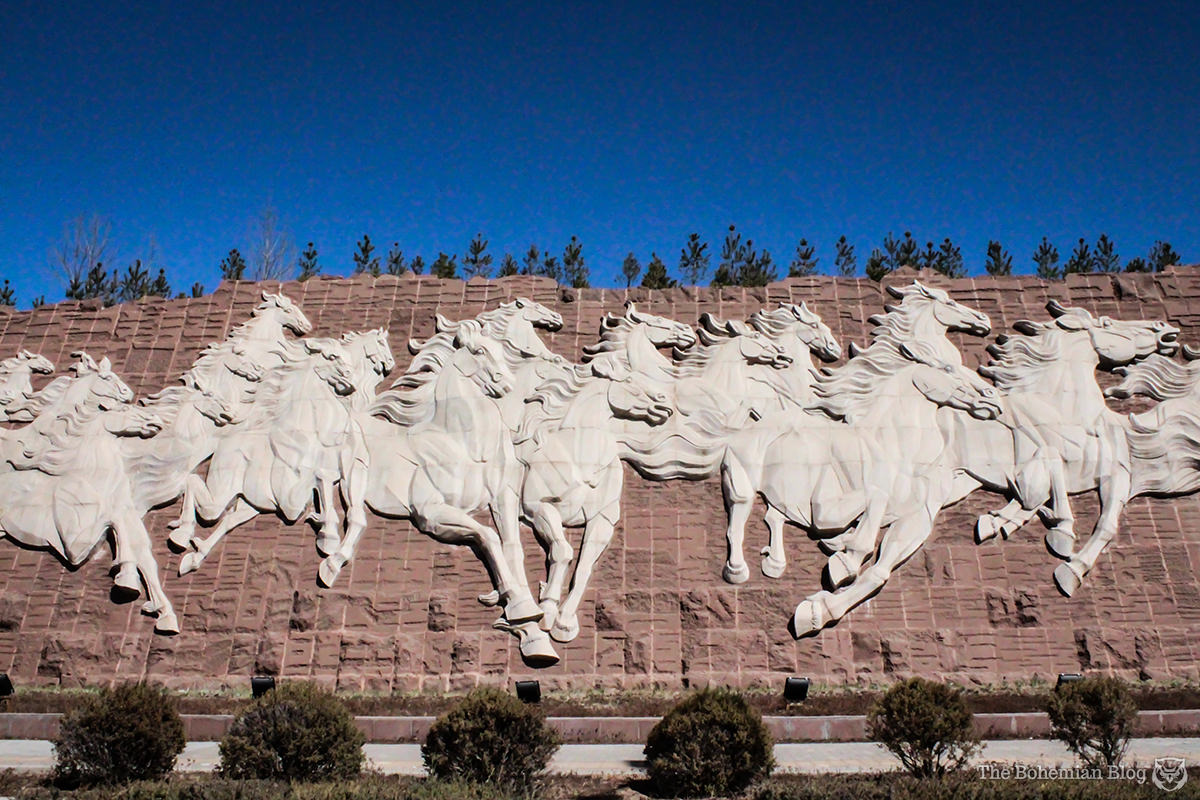 His confidence was to be paraphrased by almost every local that we spoke to on that trip; a blind assurance that these beautiful buildings couldn’t stay empty forever. It was inconceivable that all of this hard work might have been for nothing.
His confidence was to be paraphrased by almost every local that we spoke to on that trip; a blind assurance that these beautiful buildings couldn’t stay empty forever. It was inconceivable that all of this hard work might have been for nothing.
We drove back along the freeway, which links old Ordos to Kangbashi, before continuing northeast towards the airport at Dongsheng. On the way we passed by the stadium again, less dramatic by the light of day, while beyond that a forest of dusty, unfinished towers fanned out from either side of the road. Cranes stood sentry over some of these construction sites, many of them rising as much as forty, fifty stories high above the desert. In contrast, the road itself was smooth and well maintained; its shoulders and central reservation decorated with well-watered shrubs, and artistic horse motifs.
The taxi dropped us off at the top end of Genghis Khan Square, from where we gazed out across the desolation of Kangbashi. Around us rose the figures of khans and their royal advisors, of men, women and horses dressed in traditional Mongolian finery.

Roughly 600 feet to the south, at the heart of a wide, open courtyard reared up two colossal horses, perhaps the most iconic of Kangbashi’s monuments. Beyond the horses, this vast central plaza fed into a park, dusty sand in place of grass and with paths that fanned out to form the shape of a sunburst.
Residential and corporate towers rose up in all directions – a satisfyingly symmetrical alignment of blocks and skyscrapers – while before that, hemming us in, Kangbashi’s most notable works of architecture lined the paths of Genghis Khan Square. Along the left hand side, past the two rearing horses sat the Kangbashi Theatre: a curious building, its shape supposedly inspired by a traditional form of Mongolian headwear.
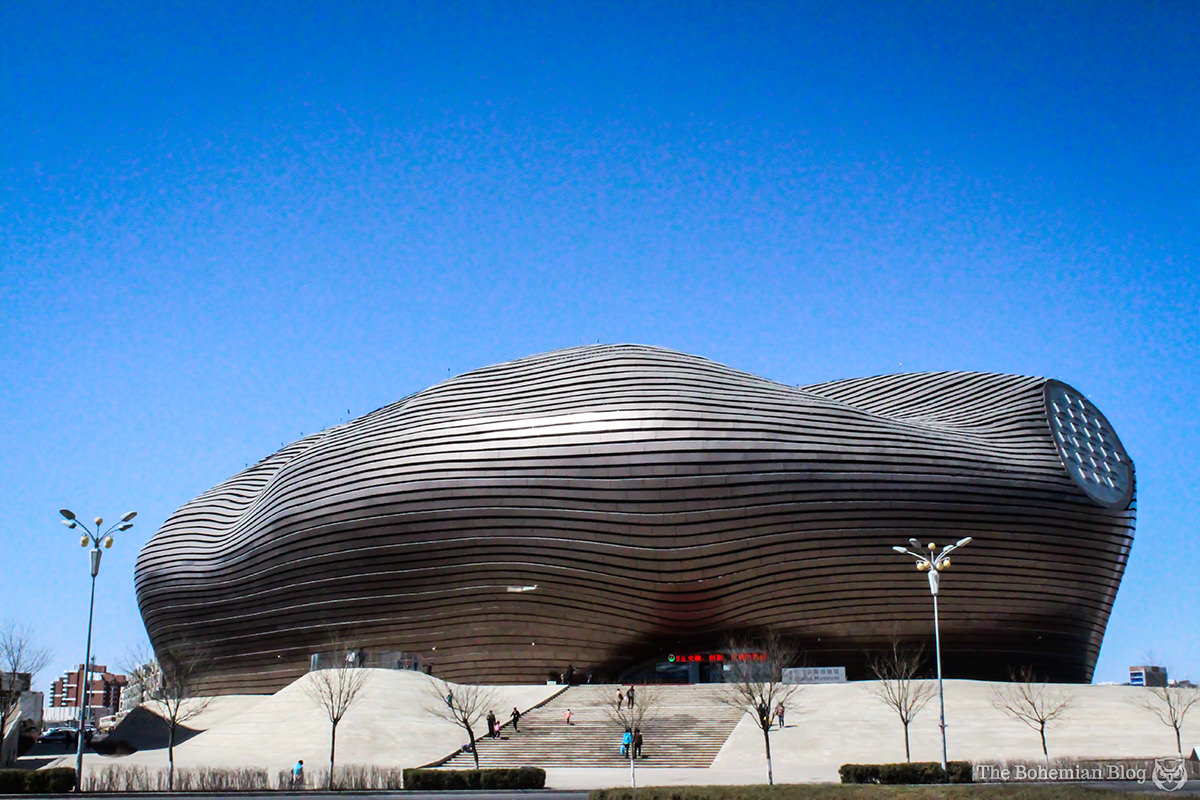
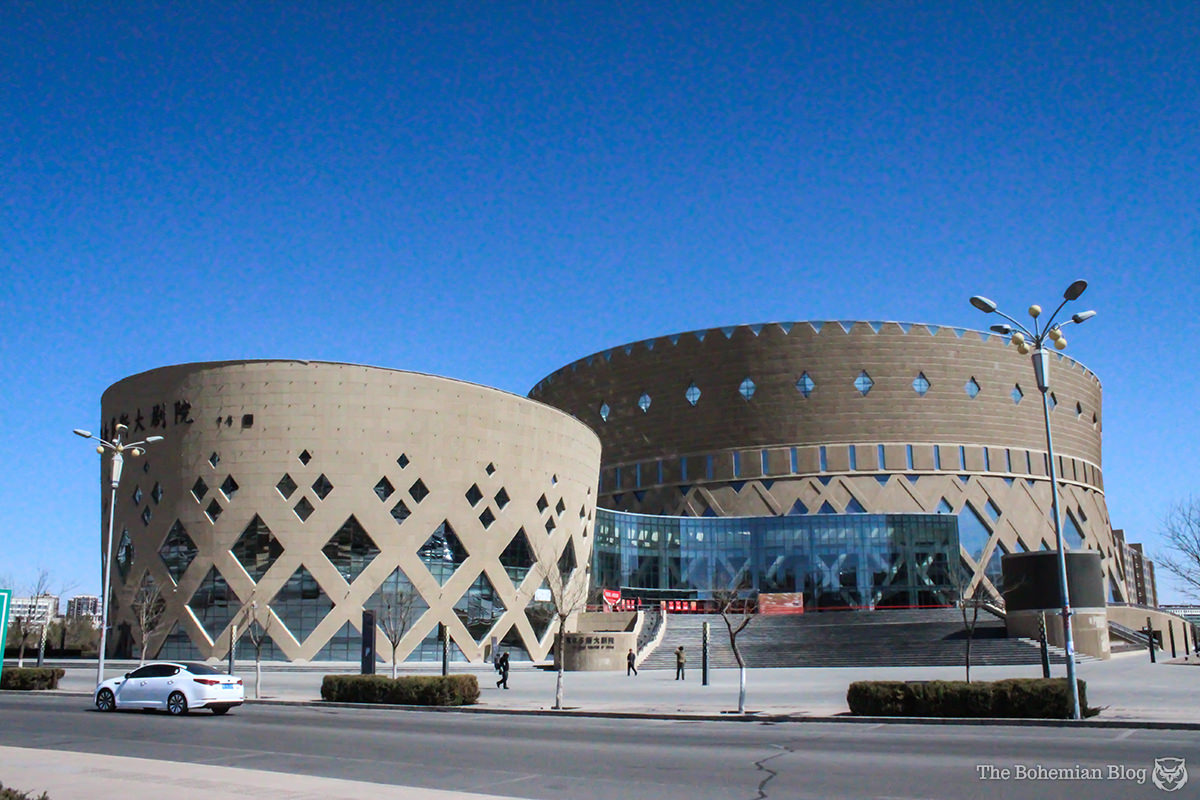
To our right, the library building resembled a cluster of leaning books while beside it, the Ordos Museum sat like… well, it’s hard to say exactly. Mad Architects, the aptly-named firm behind the project, have suggested that the design reflects, “the crossroads faced by the surrounding community which is striving to interpret their local traditions within the newly constructed urban context.”
Make of that what you will.
The square around us was not completely empty. A man watched nearby, as his son flew a kite; the bright sail drifting high above the heads of the noble khans. There was very little traffic about, but the occasional car or bike would cruise past us now and again, none of them seeming to be in any particular hurry.
There was a steady trickle of people moving in and out of the Ordos Museum, and we spied a few more stood around the horses’ hooves; though as we drew closer, we’d notice these were dressed in the drab uniforms of street sweepers. Over the course of the day, we’d find that maintenance teams in Kangbashi outnumbered pedestrians tenfold.
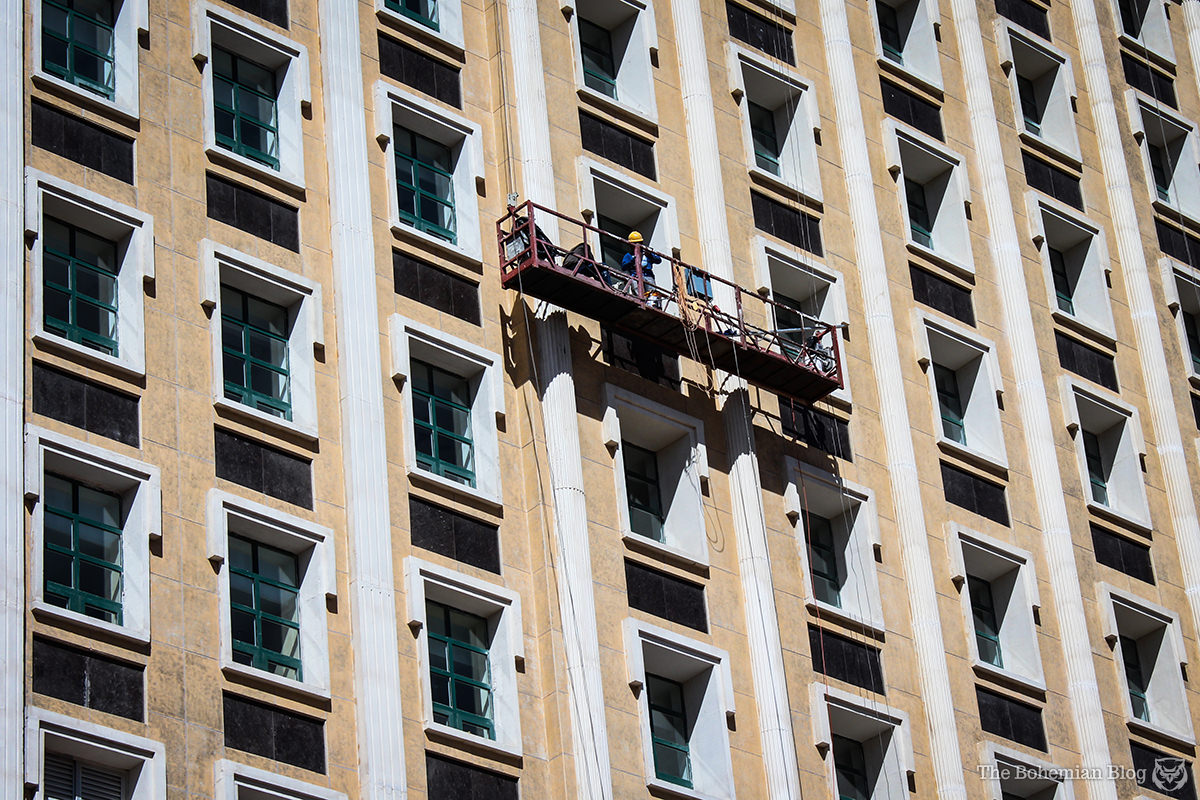

Ambling around the paths that lined the city centre, we passed small speakers mounted on stems, which blasted out Mongolian folk music to no one in particular.
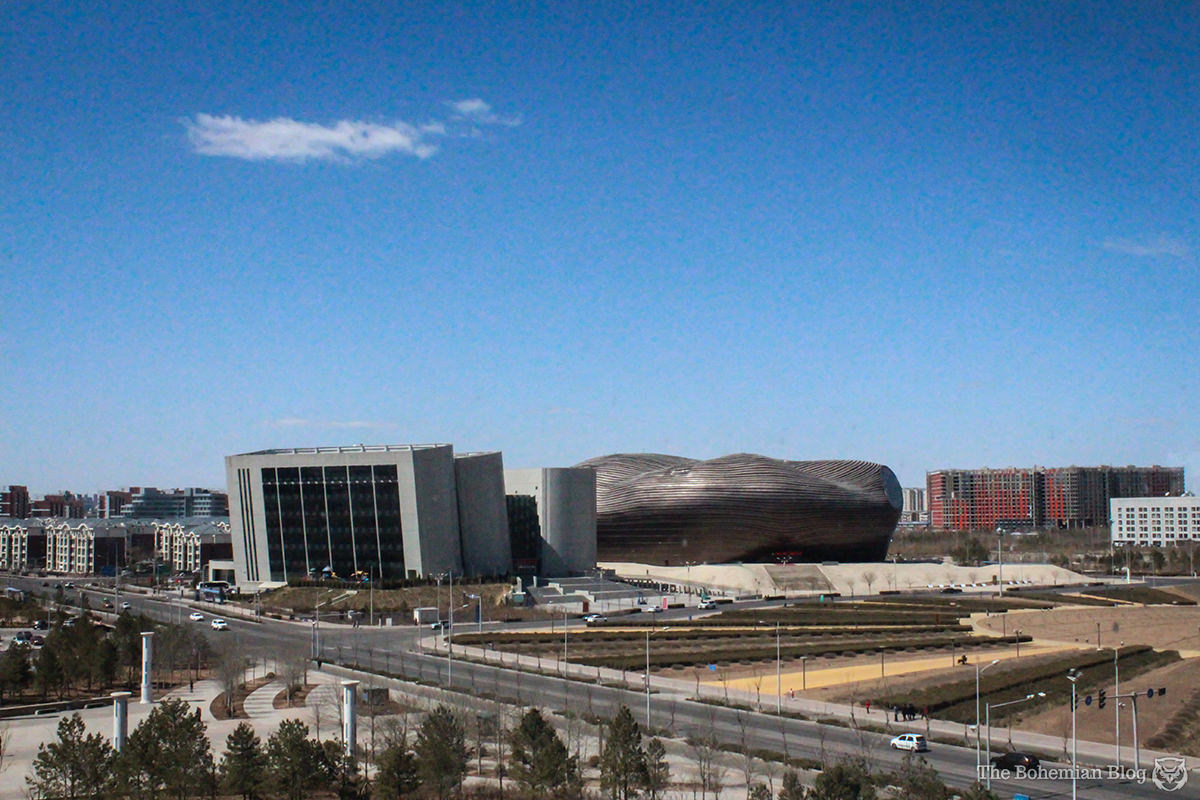 Further down the plaza, past the horses and the theatre, printed signs advertised a café and we decided to have a look inside. We took the elevator up to the top floor, where the doors opened to reveal a gaggle of giggling, school-age girls stood in a line to greet us. It looked much the same as the brothel we’d passed the night before, save that this time the girls were fully dressed.
Further down the plaza, past the horses and the theatre, printed signs advertised a café and we decided to have a look inside. We took the elevator up to the top floor, where the doors opened to reveal a gaggle of giggling, school-age girls stood in a line to greet us. It looked much the same as the brothel we’d passed the night before, save that this time the girls were fully dressed.
A wave of surprise and curiosity rippled through the staff when two foreigners stepped out of the lift. We were shown to a window seat, from where we looked down across the vast expanse of Genghis Khan Square. Kangbashi, without a doubt, was the strangest city I’d ever seen.
We had a coffee, then a beer, as we chatted excitedly about the empty streets, the bizarre monuments beneath us. This was everything we’d seen from the photographs, a surreal, desolate metropolis; ancient Mongolia spliced with scenes from the distant future, set against the swirling sands of the Mu Us Desert. Up until this point though, we’d only seen the city from the streets, from its roads and pedestrian paths… it was time to go deeper. We finished our drinks, and set off to do some proper exploring.



Comments are closed.
See all 110 comments on “Welcome to Ordos, China: The World’s Largest “Ghost City””

An illustrated guide to urban exploration in the Russian capital.

Poltergeists, ritual murder & a live-in succubus – the 1000-year-old pub with a ghostly reputation

A month-long monument hunt, and what I learned along the way.
cool
Let us assume that 30 million tons of steel,was used in the so called ghost towns,15 years ago.After 30 year. when these buildings are replaced,this will be steel scrap,and its price will be double the price.of prime steel today.The cement is a dead loss.
But let us dig deeper.Bao Steel may bill steel to a builder,at say,200 usd/ton,but the Marginal cost of that steel,might be 100 usd/ton.This is not enough.The Marginal COST To the steel cluster,in a communist nation would be 15-20 usd per ton,as the coal mines and steel factory,ports,rails,roads etc.,are already in place.The difference between the coal tarriff and the marginal cost of coal is a TRANSFER PAYMENT FROM Bao steel to the coal mine (if Bao is buying Coal)
If Coal is selling at 50 usd/ton,the Marginal Cost would be 4-5 USD (being cost of power,diesel and cost of variable labour).
So the MARGINAL COST of the Ghost towns,would be 10-15% of the contracted value of the towns.
At that time,it was the RIGHT decision to set up these “ghost towns”,as the price of steel,coal,cement,paints,labour etc., was much lower,and so was their marginal cost.It made sense to lower the ENTIRE PRODUCTION cost of these plants, by MAXIMISING production,and then using the production,in so called GHOST TOWNS.The benefit of lowering the ENTIRE PRODUCTION cost of the steel,coal,cement plants,would be in the billions of USD.IF THE SAME INFRASTRUCTURE WERE TO BE SET UP AT TODAY’s PRICES OF steel,coal,cement,the cost WOULD BE MUCH HIGHER (far beyond the accrued Chinese Inter bank interest rates over the years)
As far as the banks who lent to the builders of these so called ghost towns – it is important to understand that the Banks have NOT funded the towns.The Banks have funded the input suppliers of these towns,id.est., the steel,cement,paints, furniture and appliances etc factories. In particular,the banks have implicitly funded,the profits of these input suppliers.
Then we calculate the employment provided to a mass of labour in these ghost town projects,and its attendant benefits and the management and technical expertise,developed by the builders,in these ghost town projects.
It must also be noted that the INCREMENTAL PROFITS earned by the steel,cement,paints,furniture and appliances etc. factories,as suppliers to the builders of the ghost towns – would have in the last 15 years,based on a ROCE of 20-30 % ,yielded an aggregate return of 1000-1500% to date (with the attendant revenue streams to the PRC,in the form of direct and indirect taxes,besides other incidental gains)
Hence,for a Communist nation,the Marginal Cost for the Cluster of the “Ghost Towns” (which includes the downstream supply chain benefits and the benefits to the state) is very low and MIGHT even be NEGATIVE,based on the Marginal Cost of the CLUSTER.
If the PRC calculates the incremental gains to the steel,cement,paints,furniture and appliances etc. factories,and their staff,over the past 15 years and the revenue earned by the state from this chain,over the last 15 years,the gains per se, could more than bail out the bank loans,to the so called ghost towns
IT MUST BE NOTED THAT THE LABOUR USED IN THE GHOST TOWNS,AND THE LABOUR USED (IN PART),IN THE INPUT SUPPLIERS,TO THESE GHOST TOWNS – would have had NO OTHER employment,were it NOT for the Ghost town projects. These millions of labour were introduced into the labour pool,ONLY due to these Ghost Towns.Of course,they would have inevitably entered into the labour pool – but only after 5-10 years (on such a large scale).
Hence,there is no loss to the PRC,on account of these so called “ghost towns”.
I see you only took freshman economics.
I found similiar city ” https://www.youtube.com/watch?v=gmyisyX6U4s
The City was very beautifully built. It would seem that The Builder need to include some nomad tents areas of parks (like mobile home parks in the USA) for The annually migrating Mongolian. and more horses related competitions events…etc Perhaps that might help welcome more mongo. Best of luck guys.
The showcase of Chineese Communism, the workers have performed, but the leadership was a total disaster.
A very beautifully built city. The history was scary (Huns were the barbarians of westerner)
However a day time picture of this scantily filled city said volume of the state of it. Best of luck guys
I work a few miles from Kangbashi and it’s nothing like a ‘ghost city’ if you stay for more than a few days and see the bustle going on during the day. Kangbashi was built as the centre for all the outlying government departments and it’s slowly but surely filling up as they slowly transfer there. It’s not empty and not financially collapsing (late 2017). It even has an underground shelter in one of the public parks, which is strange for an area with no natural disasters and which made me wonder if they know something we don’t! The Mongolian museum is one of the best I’ve ever visited in the world and the ‘Food Plaza’ is amazing … I could go on and on, but don’t believe all the western hype. Yes, it’s near empty at night, the Mongolians aren’t renown party animals.
Of course, there’s a recession, but the crime rate is almost non-existent, it’s safe day or night, no street gangs and no drugs. Can’t ask for more than that 🙂
https://www.academia.edu/12117287/Inner_Mongolia_Tourist
Thanks for this, John. Good to have updates! I’d love to go back sometime, and see how it’s changed over the last 5 years.
Your text and images make no mention of Ordos B.C. You know the saying ” If you don’t know where you come from, you don’t know where you go to. Ordos was homeland and capital city of the Huns B.C. Chinese historians of old write extensively about it.
No, you’re right. There’s a lot more to the story than I have covered here – I’m aware of ancient Ordos, though I really don’t know much about it. Can you recommend any good sources?
Maybe in the near future this will be a town with millions of people. I will add a link at blog; https://producaoindustrialblog.wordpress.com/
Who knows? It could still happen. Thanks for the link!
Maybe figure out how to insert a second and tertiary tactical urbanist infill in between the big buildings and infill some of the open spaces to tune the scale of the occupied space.
Yes – I think that’s a good idea. Right now, the prohibitive prices seem to be one of the factors dooming this city to incompletion. A wider range of housing options and price ranges might just save it.
China should relocated their least productive citizens to Ordos in exchange for them (the least productive Chinese citizens) accepting permanent birth control.
You’d make a great dictator.
Or…….just get all of the refugees here.
The Chinese government have constructed so many buildings, most of them are apartments and office buildings. They should have constructed some factories or moved some factories here from other parts of china. Then population will automatically come. Why they are not thinking about that? I could not see any factories pictures in your report. Spending huge amount for constructing a city and ignoring it now is a total waste. They are destroying a nice city.
No, that’s a really good point. I saw perhaps one or two factory sites, on the edge of the city, but nowhere near enough to employ this many people. It seems like they’ve planned the whole thing backwards.
Lets rent out the city to mega rich people or to movie studios that want to make a big block buster movie.
Seems daft that movie studios go building huge city film sets, only to demolish them after – when there are empty, ready made cities like this just hanging around.
Why can’t they fill the “ghost city” with refugees and take the burdon off the European cities???
That sounds like a great idea.
Makes you wonder, doesn’t it? Someone ought to write China a letter.
Best post!!!!!!!!!When I was in Japan, many Japanese felt hatred towards the Korean culture for the atrocities of the past. Some of them said they would never forgive what happened and would never be able to visit Korea. Even nowadays there is some discrimination towards Koreans when they want to look for jobs etc.Thanks 🙂
Shouldn’t it be the other way around? I mean it’s strange that the perpetrators (not the present Japanese but during the past) of the atrocities are the ones that felt hatred.
Yes, that’s the version I’ve heard too – but then I’ve been to Korea, and not Japan. I’d be really interested to know how their perspectives vary.
I just stumbled upon your website while planning a trip to China… and I’m finding lots of good stuff! I was a bit disappointed, though, to read that you guys couldn’t find a way into Beijing’s underground city and that Wonderland was destroyed.
I’m just curious… I saw that you flew there, but do you think it would be possible stop here overland while going from Beijing to Mongolia overland? Also, were you really able to get into some of the abandoned buildings? And, just to confirm, Ordos is the name of the city but Kangbashi is the name of the district that’s mostly empty?
Once again, great article!!
Thank you, Nikki!
Yes, these places are disappearing fast. I have heard about other people finding a way into Beijing tunnels since my attempt, though – Google it and you might find a few clues.
You’re correct, the city is called Ordos and ‘Kangbashi’ is a district within it. Many of the buildings (abandoned, unfinished, or otherwise) are completely open to the elements. I have no idea about overland routes though. I guess there ought to be a train, a bus, or something? It made no sense for me to travel that way for a short visit from Beijing, but geographically it’s certainly en-route in you’re coming from Mongolia.
Hope you have a successful trip!
How long do you think it’ll be interesting to visit? There are many abandoned cities but seeing one that’s brand new and already abandoned is unique; won’t be new forever.
No, it won’t, and it’s very hard to say what’ll happen with it. According to some people, the Kangbashi district is already looking much more lived-in.
I worked here in Ordos in 2012, on the Miss World telecast. It was the most bizarre experience of my life, working in a stadium designed to hold 40,000, but with no working water supply or lavatories. The service in the ‘Crowne Plaza’ hotel was dismal, the six-lane streets deserted, the underground shopping mall empty. Every moment of travel is an experience, good or bad, and you can’t believe Ordos until you actually visit!
That sounds about right! What an interesting experience that must have been. It’s one thing to simply explore the place alone, but I imagine it must have been fascinating to see the contrast between the lavish set-up for an international event and the surrounding chaos… thanks for sharing this.
They could ship millions of refugees there to fill that wasted space up.
I just visited Inner Mongolia last week and passed by this place sorta by accident while on our way to Hohhot. We were driving and looking for food and thought this place had something since there were so many skyscrapers. Boy, were we wrong. Yes, it was a big city alright, but there was nobody around!?!?!! There were still tons of new constructions of buildings, but obviously, the city was dead. There were hardly any cars on the road. I thought it was a new town, but it’s been like this since 2003?? What i’m curious about is how the heck have the developers been able to make their payments to the banks? there appears to be no cash flow…
Interesting! I can only imagine what it must have looked like from a distance, all those towers rising out of the desert. I bet that was an interesting drive. And no, the whole cash flow situation in Ordos doesn’t make a whole lot of sense to me, either…
The article says Inner Mongolia was once the birthplace of Genghis Khan… Where is the birthplace of Genghis Khan now?
The fact that it was the birthplace then does not rule out it also being the birthplace now. These two concepts are not mutually exclusive. You’re right though, it may be something of a redundancy… I guess I probably just thought it sounded good when I wrote it.
I understand that only 5% of Chinese hold passports to travel, which means that the folks who have funds invested it in the new “ghost” cities, which are in fact, owned by ordinary citizens since the value of real estate has yet to depreciate. I live in Liaoning and even cities like Shenbei outside of Shenyang has many unoccupied buildings but they are owned. Now, if and when those buildings are occupied, the crunch may come since the cost of maintaining urban centers are considerably more than a room at the hutong. But that is where a centralized operation that has devolved powers to the provincial, prefecture and city levels has an advantage over purely free market economies that depend on the quarterly bottom line. Yes, they do look like “ghost” towns, but they are owned and it is likely that they are more futuric than just a mere waste.
Yes, that makes a lot of sense. I’ve heard about this before, that there are many empty-looking cities which are actually privately owned and full of investment money – I think what sets Ordos apart though, was the level of decay on top of that. I’m not an architect, or a structural surveyor, but in my layperson’s opinion a lot of the buildings I saw seemed to be seriously depreciating in value as a result of being left unfinished… Some were literally falling apart. So I can’t help but wonder if this city was an exception to the usual pattern?
A lot of Chinese throught southeast asia, Indonesia, Australia and others countries have invested in these Chinese cities for the past 25 years.
Not sure why everybody is so blind to what is going on here. China is preparing for the new world order. They understand that the world economy will soon implode, at which time they will launch a protectionist agenda and will alienate the rest of the world. They have the manufacturing now to supply their entire population with what it needs, and the other super powers (US, UK, etc.) are now reliant upon China’s manufacturing. They will completely restructure their currency and their internal and external economic policies. They will be in the driver’s seat. They are preparing to be the new dominant power in the world, wherein the US and Western Civilization will be relegated to oblivion. They understand this, anybody with their eyes open understands this, but we are too busy worrying about the Kardashians and what brand our Jeans are to care.
It’s certainly one explanation, isn’t it? I don’t know. I absolutely agree with the second half of your comment – the global power balance is shifting rapidly, and most people are too absorbed to notice it. As for the first half… well, I guess we’ll have to wait and see. Thanks for the comment, anyway.
I couldn’t agrees less sorry. Having spent a lot of time China one is able to separate the rhetoric from reality. Whilst the Chinese think they are going to rule the world, the reality is that they haven’t got the ability to do it at this stage, nor the moral authority to back it up. China has gone from peasantry/abject poverty to developing country status in less than 2 generations. In the west our development has been crafted over centuries. Like a steel blade in a fire. There has not been enough time for china’s institutions and people to mature to the level that we see in the West today. Yes the west can be decadent, and there will be economic corrections for this, but I don’t see a case where the Chinese can overtake the west within the next 30-50 years. Being a world power is more than just economic gdp. it is also moral leadership. Nobody looks to china to solve world problems when there is a conflict somewhere. It is always the UK or US that has to be involved. There is still a lot of ignorance in China. I am amazed that they have come so far so quick in terms of infrastructure development, and they can certainly teach us a few things about efficiencies in infrstrastrcture development, but they still do not have the people skills to match the west. Until such time as China is seen as a country that other countries can look up to in a time of crisis, and who can provide leadership to other countries, then it will just be seen as a source of manufacturing for mass produced products. They have the hardware so to speak, but not necessarily the software. Having said that, I admire how far they have come in such a short period of time,
Nope. Just like every other country that developed through manufacturing, China’s people will become too educated and not want to do low-paying manufacturing work. Manufacturers will leave and find cheap labor and corrupt governments elsewhere.
The chinese build giant empty cities while this is still going on. Located in the Shanxi province in China this city is the worst city when we are talking about pollution. http://www.lazypalace.com/img/lifestyle/slums/slums06.jpg
Hong Kong’s Kowloon Walled City
http://metropolismag.com/images/cache/cache_0/cache_f/cache_8/walledcity-692968f0.jpeg?ver=1415375740&aspectratio=1.6455696202532
Suzhou
http://www.navjot-singh.com/uploads/3/1/7/4/3174873/1842571_orig.jpg
File:Shibati Chongqing China Slum Dwelling November 2010
http://upload.wikimedia.org/wikipedia/commons/b/bf/Shibati_Chongqing_China_Slum_Dwelling_November_2010.jpg
I will throw this one in as well, not in China so to speak.
Phuket, Thailand
http://cdn.lightgalleries.net/4bd5ec0255078/images/07_Thailand_Burma_1-1.jpg
I had this chinese girl at a local bar try to convince me that India and China are “the dominate peoples”.
The only domination I see them doing is dominating the worst living conditions, largest slums, most environmentally destructive construction practices and the most possible epicenter for a disease driven mass extinction event. Way to dominate over population, undereducation and slum building India and China. Way to dominate destroying your own history and sustainable ways of life in trade for plastic garbage and slums filled with the people ruined, tortured and destroyed by it. Keep up the good work!
http://academic.evergreen.edu/curricular/culturallandscapes/MegaCities-2015-PGM.jpg
Thailand doesn’t have anything to do with this – and as for Kowloon Walled City, I don’t think you can blame that on the Chinese alone. Much of the reason for its overpopulation was the tension between British- and Chinese-controlled districts in Hong Kong, and so European colonialism shares the responsibility for the outcome.
I’m sorry to hear that you’ve only heard bad things about China! You should go there some time – you might be pleasantly surprised.
True.. I really respect your comment,
It’s amazing the empty cities in China ( 4x our population), built from the scrap metal China buys from around the world…as the U.S. sells out it’s industrial cities as scrap. Simply amazing.
I had heard that China were importing a lot of scrap metal – I wonder how much of Kangbashi is built using it. Definitely a cheap way to construct a city. It’ll be interesting to see how long it stays standing though!
I am sure most of the “scrap” metal is going into manufacturing and construction. But construction for of what for whom? China seems more concerned about how it looks than who and what it is. Eventually they will have to re scrap the steel from many of the large failed building projects. I believe China is doing this in an attempt to prop up their economy. Building these cities with barely anyone in them and in some cases, with no one in them at all. Building for the sake of building is just a waste of time, effort and resources.
It certainly seems to be a gamble, in some cases.
Impressive. Thank you for the great story
You’re very welcome! It certainly is an impressive place.
I don’t know about anyone else but I’m ready to make a movie here. Perfect location
It’s amazing how many film studios build massive fake sets out in the middle of nowhere – when there are whole cities like this standing empty.
This is B**S****. Not a single picture of Dongsheng? everything is Kangbashi? What’s the purpose of this post?
Hi Alejandro, are we looking at the same article here? As stated above, the airport photographs are taken in Dongsheng Airport, along with the highway bridge (that’s five images, the 7th featured here along with images 9 through to 12). Only 12 of the 28 images in this post were taken in Kangbashi… you’ll find these under the sub-heading “The Kangbashi New Area.” I thought that would be fairly self-explanatory.
As for the purpose of the post – that’s for you to decide. I’m just putting it out there. Thanks for commenting!
Chinese upper brass knows that some sort of global disaster may be ahead. Since they have total control there, it’s possible to build spare cities to use afterward. Ask yourself why giant underground bases are being built, in a hurry, worldwide.
Yeah, it’s definitely plausible – I saw a few underground areas at Ordos too, but there was evidence of much more hidden away beneath the city. Who knows? You might be onto something.
so amazing!!LOVE IT!!
It’s a really incredible location, isn’t it? I’d love to go back in 10 years and see what’s changed.
Outstanding work on dark tourism..I live in a former communist country,Romania.Maybe you will find an interesting place here too.Hopefully I’ll get to visit some of these places also
Mulțumesc, Radu! I’m really glad you like the website. Actually I’ve written 3 posts about Romania already, including one on Bran Castle… I’ve got a lot more material still to publish though. I have spent a fair amount of time in Romania already, but it’s such a big country, with so many interesting places to see, that I know I need to come back and explore some more one day!
Hi Darmon – Great article! I will be heading there this weekend (by myself, for research) and this article is a good heads up on what I should expect. Any traveling tips you could give? Were taxis hard to find? And please let me know if you know anyone there I could contact for some support; that would be lovely. Thank you!
Hey Diana, hope the trip goes well! Taxis were relatively easy to flag down in the older part of Ordos, and they’re very cheap. There are not so many in Kangbashi, though still a few floating around. Do you speak any Chinese? There’s not a lot of English spoken there, though certainly some of the younger generation are likely to be able to help. Like most places in China though, people are friendly so you can generally get by with sign language and smiles. Hotels were pretty easy to find, though again, you’ll find more of them in the older parts of town. Sorry to say though, I don’t have any local contacts in Ordos. Let me know if there’s anything else I can help with though!
Your link for part two doesn’t work. Please update, can’t wait to read it!
Thanks for pointing this out – I recently had the website redesigned, and there are still a few small bugs. Anyway, I’ve been away all weekend, but just got back and have now fixed the link. Hope you enjoy Part Two!
It has a very similar structure/blueprint as the city in Astana, Kazakhstan (https://www.exutopia.com/2012/12/dark-tourism-illuminati-capital.html) // Looks like it didn’t thrive for Mongolia, or location was moved abruptly.
That’s a good point, actually. There’s definitely some similarity between the two – not just the weird architecture but the layout and the landscape too. I wonder if there was any crossover between architects / design teams… I know that Astana was largely planned by outsourced, foreign architects, but I’m not so familiar with the rationale behind Ordos. Anyway, thanks for bringing this up – it’s an interesting point.
Proof that the “economy” builds the most useless shit on Earth. This is the result of a sickness called the Military Industrial Complex. Absolutely shocking and a disgrace to the environment.
Yes, the environmental factor is pretty shocking when you think about it. It seems though, that this approach toward building cities in bursts can often be successful; you see it happening all over China.
I think in the case of Ordos, what we’re looking at is the result of bad planning, and perhaps bad luck. That’s not to excuse the effect on economy and ecology, but nevertheless I think this result is a rarity.
Just think if they actually helped people what they could do.
One of the weirdest places on earth!
Yes, it really is.
How did you get there? any advice?
It’s not too hard to get there, though I don’t think this trip would have been possible without the help of my Chinese-speaking friend. We flew from Beijing to Ordos airport, then travelled by taxi to Kangbashi.
Although, having said that – my friends over at Young Pioneer Tours have just started running tours to Ordos! You can get a discount too, if you mention ‘Ex Utopia’ when you book.
This is utterly amazing! I’m going there in few weeks. Can’t wait! 😀
Brilliant! Are you going alone, or is this an educational trip? Hope you enjoy yourself, it really is a fascinating place.
Soooo no pictures of the prostitutes or the sex shops…did your camera break? What gives?!
Haha, no… I did actually have my camera with me at the time, and nearly took a picture. But then I decided that it didn’t really feel fair, and so I focussed more on the architecture instead. Architecture doesn’t mind being exploited.
wonder why the movie “I am legend was not shot here”
I agree, that would have been perfect.
This is an amazing account.
Though, just as amazed about this report, I am amazed at the fact that you, the writer, did not venture and make the piece more complete.
By making an analysis of the facts, of why this building site did not mature into a city. You would have elevated your writing from a “look at the crazy neo billionaires building fata-morgannas and burning dough.” To an even better piece than just a real nice contribution.
That IS something I would truly have been interested in…
But of course it’s much easier to complain. So, sorry for that.
Thanks for the kind words, Daniel.
I appreciate your criticism – I, too, would love to read an account which really tackles the facts here, analysing how and why the city of Ordos (and other “ghost cities”, for that matter) came to be the way they are.
However, that’s just not what I do. I have no education in economics, and I fear that any analysis I wrote would ultimately risk being flawed, ill-informed, and therefore devalue what I can contribute…
…which is an honest and thorough examination of the symptoms on display here. I leave it to others, those with a better working knowledge of economic and sociopolitical processes, to join the dots and offer their prognosis.
Fascinating post. I’m starving here for a proper *explanation* of just how something like this happens. Any idea if any sociological work has been done on China’s ghost cities? This is just crying out for an explanation.
Thanks for your comment, Andres.
I’m yet to read anything that gives a true and complete explanation for how this happens. There are theories that China’s economy tends to work this way though, through a process of “boom and bust”. For example, there are many empty buildings in Shanghai still – the country goes through periods of rapid infrastructural growth, which are later followed by mass movements of population into the new spaces.
I guess in this instance though, it just didn’t work out as planned.
There are some very strange and fascinating things in China-
Never was a truer word spoken.
Very interesting! Didn’t realize the occupancy was as low as 2% at one time. Just wrote an article on the broader impact of ghost cities in China and found that the 20 million Chinese are moving from the countryside to cities each year. Maybe someday they will fill up!
http://www.cityclock.org/ghost-cities-in-china-on-the-rebound/
It’s completely possible that these places will fill up in time. However, the problem for Ordos is that many parts of the city have been left empty for too long… as I noted above, there are signs of serious wear and decay, in buildings which haven’t even seen an occupant yet. I fear that in this case, the prophesied population boom has come too late.
Thanks for the link to your own article, I’ll be interested to read your perspective on this.
it won’t happen cause the displaced rural poor have nothing to invest. their land was stolen from them by water mining > water table drop and industrial agriculture. millions will die but Ordos won’t live. read here http://www.derrickjensen.org/work/endgame/endgame-premises-english/
Good article, and some very fair points. Thanks for adding this perspective.
That looks so surreal. Must have felt like being in some type of Eerie zombie film or something?
Yes – that thought went through my head a few times! Truly post-apocalyptic.
Amazing place. I don’t know about a second Death Star, but that airport looks like the rotunda in Deep Space Nine. Great post as usual.
You should have seen it at night, Dale… sadly I couldn’t get a worthwhile photo out the window of the coach, but that place was epic.
this is fascinating great post and you may enjoy @yomadic
Thanks Rebecca, glad you found it interesting!
And yes, I know Yomadic well – in fact, we’ve shared more than a few adventures already…
Fantastic! I’ve wanted to see this city from the moment I heard this happens in China. Love it that you’ve made what seems to be a proper inspection to the interesting side. Looking forward to the next posts. Keep us great work!
Thanks for the comment, Heidi! I was exactly the same – as soon as I heard about this place, I knew I had to get out there for myself.By the way, I’ve just posted Part 2: Urban Exploration in Kangbashi